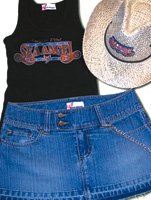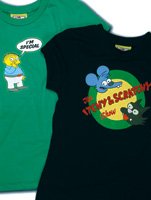Finding Fortune in T-Shirts and Surf
Vernon, Calif.–based T-shirt company diversifies with strategic licensing agreements and a partner in surf
After nearly 15 years in the T-shirt business, Fortune Fashions Industries is finally living up to its name. The company’s good fortune: two licensed brandname apparel labels, private- label distribution at mass retailers, and sales on track to exceed the $100 million mark.
Business partners Fred Kayne, Lee Rosenblatt and Jonathan Hirsh said a reputation for quality and creativity opened doors for the Vernon, Calif.–based T-shirt maker, whose accounts include all the country’s top theme parks.
If the permanent smiles on the executives’ faces aren’t a sure indicator of how good business is, then maybe the company’s voluminous production schedule is a testament to all things prosperous.
In recent months, the tops-driven apparel maker secured licenses to produce privatelabel T-shirts and sweat shirts for mid-tier and mass retail chains and acquired the rights to produce “The Simpsons” T-shirts and sweat shirts for juniors and distribute them to mass retailers. It also acquired the licensing rights to produce two surf-inspired branded apparel lines.
“It’s brand integrity,” Hirsh said. “We learned how to get behind a brand and keep the integrity of what the brand means.”
Hirsh added that producing licensed Tshirts is not that much different from the company creating its own branded T-shirts.
“That’s our foundation and how the business got created,” he said. “We built a model with high expectations in place, so now that we’re expanding, we’re able to carry out and deliver upon those expectations wherever we go.”
Several of Fortune Fashion’s longtime tourism buyers joined mass retailers, which helped the company make an entrance into mass-market channels, Rosenblatt admitted.
“We like to think that we’re in the design and marketing business,” he said. “We just happen to do it on T-shirts and sweat shirts.”
Growing company
Taking on mass-volume production should be a cinch for Fortune Fashions, whose workforce has grown from 100 employees in 1991 to 1,000 employees, including printers, dyers, designers and graphic artists. In recent years, the company moved from its 50,000-square-foot warehouse into a 430,000- square-foot design and manufacturing plant in Vernon’s industrial center.
The privately held T-shirt manufacturer, which imprints roughly 2 million garments each month, plans to increase its sales and production staff by 15 percent this year. The company is also ramping up its sourcing capabilities and adding additional embellishment machinery to increase its capacity by 25 percent.
Fortune Fashions buys blank T-shirts in knit and woven fabrics—including jersey, fleece, ribbed, twill and yarn-dyed fabrications— from local vendors and then performs dye treatments including rain wash, acid wash, neon coloring, dip dye and crystal wash. The apparel company keeps a low overhead because it owns all its machinery and, subsequently, carries all its own receivables. The company prides itself on the fact that it has always paid its vendors, banks and equipment suppliers on time.
Fortunate beginning
Business has not been this good for Fortune Fashions since the early 1990s, Rosenblatt said. A third-generation apparel maker, Rosenblatt used to sell screen-printed T-shirts to theme parks and airport souvenir shops under the Harry Rosenblatt & Sons banner. A sharp decline in consumer spending at the onset of the Gulf War forced Rosenblatt to declare bankruptcy.
Around this time, Rosenblatt met Fred Kayne, a retired businessman who was looking for a business venture. Kayne agreed to buy the ailing company from the bank, and appointed Rosenblatt and the company’s sales director, Jonathan Hirsh, to run day-today operations under a new name: Fortune Fashions. A few years later, Kayne made Rosenblatt and Hirsh his partners, and together they have wrestled with ideas on how to increase the company’s market share.
“When we first started, we also sold to a lot of little stores,” Rosenblatt explained. “It took us a little more than a year to figure out that by focusing on large accounts, we had a much bigger upside and growth potential.”
Diversifying the business
Fortune Fashions prospered from the spurt in travel and tourism during the late 1990s until Sept. 11, 2001.
“The Gulf War made things difficult, and 10 years later, the travel industry was being affected again,” Rosenblatt explained. “We’re so much more financially strong, but it also opened our eyes to see that we shouldn’t solely rely on the tourist industry.”
Fortune Fashions began to refocus its attention on new channels of distribution and licensing opportunities. The company also realized that it had to provide helpful trend information to give its customers an edge over competitors. Besides being up-to-date on the latest trends, the business offers clients a proprietary portfolio that includes foil treatments, embroidery, hot stamping, embossing, flocking, nailheads and print/embroidery combinations.
“We provide our accounts with proven facts of what type of prints and treatments are doing well in the market,” Rosenblatt explained. “We go to our customers and tell them about trends, and we’re continually developing new ideas, and any new idea that comes out, we jump on it and make sure we do really good quality.”
These days, Fortune Fashions has two goals in mind: long-term growth and stability. With solid footing in the private- label market, the company entered the branded business in 2002 with licenses to produce Rietveld USA and Sea Angel, surf-inspired lines conceptualized by graphic artist Rick Rietveld, in the United States, Canada and Japan.
Rietveld, a well-known graphic designer in the surf industry who helped conceptualize Maui & Sons, is known for his highly detailed graphics and fantasy settings. Rosenblatt and Hirsh are enthusiastic about Rietveld’s talents.
“He’s the Salvador Dali of the surf world,” Hirsch said, pointing to a men’s dress shirt with a print of a palm tree–lined beach and ocean waves at nighttime. Upon closer inspection, the palm trees transform into pin-up girls bathing in the moonlight.
Branching out
After years of keeping a low profile, Fortune Fashions is beginning to launch advertising campaigns in consumer- and actionsports publications, including Surfer Magazine, LongBoard Magazine, SG Magazine and Eastern Surf Magazine. Female pro-surfer Mary Osborne and Rietveld have lent their support to in-store promotions and trade shows.
“We’re trying to do a lot of grass-roots stuff, and it’s a lot of fun so far,” Rosenblatt said. “We’ve made the commitment to invest in marketing because our branded business is a small part of our overall business—which has grown and matured substantially—and we have the financial resources to do it. We think we’re making an investment for a couple of years that will pay off down the road for us.”
Fortune Fashions is also launching a tops-driven apparel collection that crosses over into different sports categories. Method Research—sponsored by motocross, snow, skate and surf athletes— will target young boys and men with youth-oriented Tshirts, sweat shirts and headwear. The line is set to bow for Backto- School 2004. The company will add bottoms to the line gradually, Rosenblatt said, noting that several mid-tier retailers have already expressed interest in the brand.
Rosenblatt and Hirsh agreed that Fortune Fashion’s entrance into the mass retail markets and branded business could not have been accomplished without the strong footing provided by the company’s private-label business.
“We’ll continue to look at new opportunities and measure each on their own because we have another strong business that takes care of everything—it pays the rent and takes care of all of our overhead,” Rosenblatt said. “We want to make sure the investment is proper and that we get a good return on our investment eventually. We can be patient and wait for it.”
























